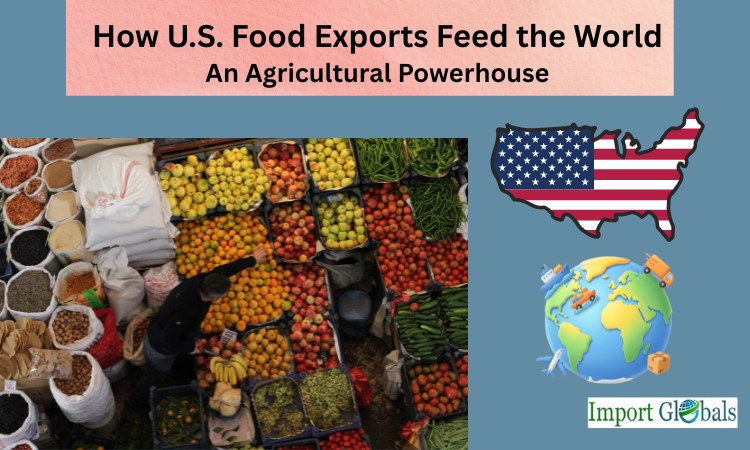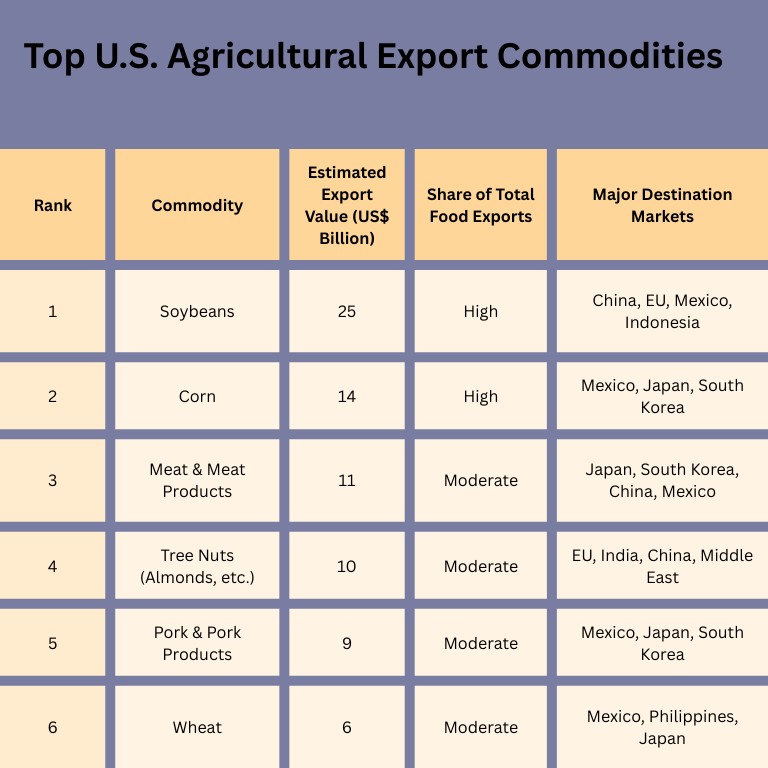
- Nov 25, 2025
How U.S. Food Exports Feed the World: An Agricultural Powerhouse
U.S. is very vital for feeding people all around the world since it has a lot of farms, advanced farming tools, good shipping, and strong trade ties.
People have known for a long time that the U.S. is one of the world's top agricultural exporters. As per USA EXPORT DATA by Import Globals, the U.S. is very vital for feeding people all around the world since it has a lot of farms, advanced farming tools, good shipping, and strong trade ties. American farms and agribusinesses grow and sell grains, oilseeds, meat, dairy, and fresh fruits and vegetables to practically every area of the world. As the globe needs more safe food supplies, the U.S. is still at the center of global food security.
The Importance of U.S. Agricultural Exports Around the World
Food exports from the U.S. aren't just a business; they are a big element in getting food to people all around the world. As per USA IMPORT EXPORT TRADE DATA by Import Globals, the U.S. is always one of the leading exporters of corn, soybeans, wheat, nuts, meat, poultry, and dairy. These exports aid both rich and poor countries who need to buy food by keeping prices stable, giving them more food options, and helping their processing industries.
A lot of what the U.S. sends to other countries goes to places where the population is growing and the need for food is growing. Countries in Asia, North America, Europe, and Latin America all rely on U.S. goods to suit their own needs. This is especially true for large amounts of grains and oilseeds, which are the key parts of the world's food supply chains. Climate change is making crop yields different in different places of the planet. As per USA IMPORT CUSTOM DATA by Import Globals, the constant production of U.S. agriculture helps keep food markets around the world stable.
How Much and How Far U.S. Food Exports Go
Every year, the United States sends farm goods worth hundreds of billions of dollars to more than 100 other countries. As per USA IMPORT TRADE ANALYSIS by Import Globals, a lot of these exports go to significant trading partners including Mexico, Canada, China, Japan, and South Korea. These collaborations work because they have integrated supply chains, trade agreements, and a constant need for high-quality agricultural goods.
As per USA EXPORTER DATA by Import Globals, North America is still one of the main customers of U.S. farm products since it's close by and easy to get things to. On the other hand, East Asia has a big market for cereals, oilseeds, and meats. This is because people are eating more protein, food processing is becoming more industrial, and most of the feed for cattle comes from other nations. This wide reach shows how closely U.S. agriculture is tied to how people all across the world consume.
A lot of different foods come from the U.S.
As per USA IMPORTER DATA by Import Globals, the U.S. exports a lot of different kinds of farm goods, but some groupings of goods are valued more than others. These are:
Oilseeds and their by-products, such as soybeans and soybean meal,
Grains and feeds, such as corn and wheat
Animals and Meat Products
Horticultural Products (such fruits, nuts, and vegetables)
Dairy and Processed Foods
As per USA IMPORT TRADE STATISTICS by Import Globals, one of the most important products the U.S. sells to other countries is soybeans. People want them to feed animals, cook with, and make food. Corn is next on the list, and it is very vital for food for people and animals all around the world. Meat exports, such meat and meat products, have grown a lot because people are making more money and eating more protein in many countries.
High-value horticulture exports including almonds, walnuts, berries, and fresh fruit have expanded quickly as consumers all around the world hunt for more healthy food choices.
The Most Important U.S. Exports in Agriculture

Why the World Needs Food from the U.S.
1. A lot of cropland that is very productive
As per USA IMPORT SHIPMENT DATA by Import Globals, the US has millions of acres of fertile land that can be used for agricultural on a massive scale. With the use of sophisticated seeds, irrigation, automation, and data-driven agricultural practices, it is possible to get high yields and a continuous supply.
2. Being the first in technology
Better supply chain systems, biotechnology, automation, and precision farming all help cut down on waste and make things flow more smoothly. This gives the U.S. an advantage in both quality and production.
3. A solid infrastructure
Highways, train systems, ports, and grain terminals are all pieces of a transportation network that makes it easy for farmers to send their goods to markets all over the world. As per USA IMPORT EXPORT TRADE ANALYSIS by Import Globals, this keeps prices down and cuts down on waste.
4. Agreements and partnerships in trade
The U.S. has a lot of trade connections that make it easier to guess how much will be sent abroad. Countries in North America, Asia, and Europe have formed treaties with each other to make sure that countries that import food will have enough of it in the long run.
5. Being reliable when things go wrong
The U.S. has often been a reliable supplier of food during times of trouble around the world, such as pandemics, droughts, or geopolitical upheavals. This has helped keep the world's markets stable.
How U.S. Food Exports Help Keep Food Safe in Other Countries
Some countries can't grow enough food at home because they don't have enough land, the weather is unfavorable, or there are too many people. As per USA EXPORT IMPORT GLOBAL TRADE DATA by Import Globals, exports from the U.S. help fill these shortfalls. For example, grains and oilseeds aid the parts of the livestock industry that make eggs, meat, and dairy.
Wheat and corn are needed to make bread, pasta, cereals, and processed foods.
Soybeans and meal are particularly significant for the poultry and aquaculture industries around the world.
Exporting meat and dairy makes more protein accessible when domestic production is limited.
The U.S. is a key role of lowering food shortages, keeping prices steady, and helping importing countries grow their economies by giving them both raw materials and high-value goods.
In the future: Feeding a world that is getting bigger
There are more people in the world, more cities, and more money to be made. As per USA import data by Import Globals, all of these elements will keep making people want more food, especially protein and processed meals. due climate change is affecting food production in some places, the U.S. will probably stay a significant exporter due of :
More and more eco-friendly farming is happening
Growth in foods that are plant-based and have added value
More and more people want it from fresh markets
Putting money into ports and logistical infrastructure
More and more individuals are interested in farming and conservation that are good for the environment.
Even if Brazil, Argentina, and the European Union will be greater competitors, the U.S. will still be able to stay in command because of its size, technology, and trade networks.
Last Thoughts
The United States is a major agricultural power that sends significant food products to many countries throughout the world. Grains, oilseeds, meat, dairy, nuts, and processed commodities are some of the things it exports that are important to food supply chains around the world. The U.S. farming industry helps feed billions of people and keeps food security stable all across the world. It does this with a lot of money, the latest technology, and strong commercial ties. As demand develops, the U.S. will still be a key element of the world's food system. Import Globals is a leading data provider of USA import export trade data.
FAQs
Ques. What countries buy the most food from the U.S.?
Ans. Some of the biggest countries that buy goods from other countries are Mexico, Canada, China, Japan, and South Korea. They buy oilseeds, cereals, and meat.
Ques. What is the most valuable agricultural product that the U.S. sells to other countries?
Ans. Soybeans are often the most lucrative export, followed by grains, beef, nuts, and animal products.
Ques. What makes U.S. food exports important to the rest of the world?
Ans. They help keep food prices stable, keep livestock production going around the world, and make sure that people can always get critical foods.
Ques. How much more food will the U.S. export in the future?
Ans. Increased demand in Asia, new technologies, farming practices that are beneficial for the environment, and increased exports of high-value items are all likely to lead to growth.
Ques. Where to get detailed USA EXPORT IMPORT GLOBAL TRADE DATA?
Ans. Visit- www.importglobals.com
